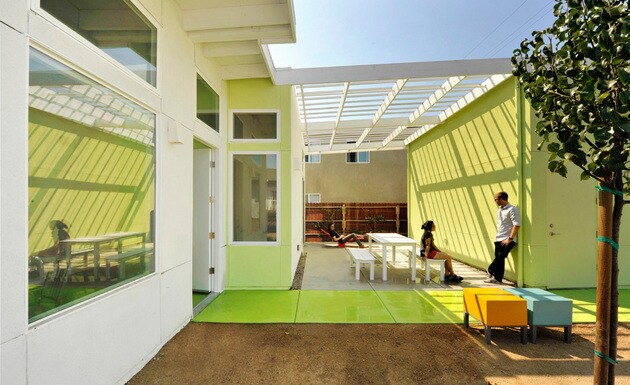Not Your Typical House Tour: Affordable Housing Prototypes in South L.A.

On Sunday, March 23, the American Institute of Architects, Los Angeles Chapter (AIA | LA) hosted a panel and tour of recently constructed affordable housing prototypes erected in South L.A. The tour allowed participants to engage in the more everyday L.A. residential streets, compared to the celebrity home tours in L.A. made famous by the infamous 'star maps' that parade the affluent Westside and Hollywood Hills residential spectacles.
The tour started with a panel held in the outdoor plaza of the Watts Towers. This only amplified the feeling that this was not your typical home architectural panel, as the participants and panelists were immersed in the sights and sounds of Watts -- the rumble of the Metro Blue Line roaring by; the growls of lawn mowers and blowers used by the gardeners at work on a Sunday morning.
The panel explained that the housing reconstruction initiative was inspired by a Federal Neighborhood Stabilization Program (NSP), aimed at utilizing Federal funds to acquire and rehabilitate (in this case, reconstruct and build new) foreclosed properties in L.A.'s hardest hit communities during the recent recession. The funds were administered locally by the L.A. Housing and Community Investment Department (HCIDLA), and Restore Neighborhoods Los Angeles (RNLA) served as the non-profit arm to implement the reconstruction projects across properties, such as the ones identified and acquired in South L.A.
Deemed as not practical to rehabilitate, the properties highlighted in Sunday's tour were programmed into a reconstruction program that aimed to not only re-build the single-family houses, but also bring opportunities for new and sustainable design technology into the construction process. RNLA executive director John Perfitt says that a driving question behind the reconstruction program was, "how can we introduce unique design to neighborhoods such as South L.A. that have not historically had the opportunity to benefit from such modern efforts?" RNLA's innovative reconstruction program issued a Request for Proposals for the design work and two architectural firms won the jobs, splitting the 12 acquired South L.A. properties slated for affordable housing prototypes.
The houses on tour Sunday evolved from the work of Lehrer Architects (LA). Principal Michael Lehrer saw the design work as a job that first consisted of "falling in love with the streets and neighborhoods," where the houses were being constructed and ensuring that the designs made a "public gesture of respect to the surrounding neighborhoods while respecting the privacy of the future home dwellers."

What resulted are well-designed houses that stand out as modern and beautiful residential structures, interspersed from 52nd to 99th street in South L.A. Built within the constraint of 12,000 square foot lots, the houses take advantage of L.A.'s climate with the smart utilization of windows that allow natural light to illuminate the inside of the house. Prioritized by Lehrer Architects was circulation, as the living spaces are designed for freedom of movement, human interaction, and sight. The ceilings were designed to be high in order to let air circulate more freely. Environmental sustainability was also a noticeable design priority, as front and backyard landscapes featured vegetation and rock gardens adaptable to L.A.'s desert climate. This particularly drove home an important point given the current drought crisis in Southern California.
With any housing innovation in urban communities comes questions we all have to grapple with. One is the idea of whether the housing featured on the tour is affordable in South L.A., with the current price tag of $295,000 to $315,000. More important, as AIA | LA moderator Will Wright expressed, is whether single family housing is the way forward in urban communities across L.A., such as South L.A., Boyle Heights, and Historic Filipinotown, among others. The increased population in such neighborhoods may indicate the need for more density, transit-orient development, and multi-family dwellings.
One design aspect of the houses noticed by some of the tour participants was the replacement of front porches with a more central outdoor gathering area embedded between the front garage structure and the main unit of the houses. This added an alternative take to outdoor L.A. space, as many of the houses along the South L.A. streets visited have the traditional porches that mark the fronts of many of the existing houses on the streets.
Lastly, such housing innovation featured on the tour is faced with the reality of how change is received by neighbors who currently live and have lived for many years in these neighborhoods. One group of neighbors with whom I had a conversation (they did not want to be identified by name) asked whether one of the tour houses on their street really fit the neighborhood's character. The group of neighbors respected the genuine motivation behind the house reconstruction effort, but didn't feel it was the best idea to erect a modern house that "looked more like a house that belonged on the Westside."
Ultimately, housing innovation will continue to be in dialogue with L.A.'s traditional physical form as the city grows older.


For more information on AIA|LA tours visit www.aialosangeles.org